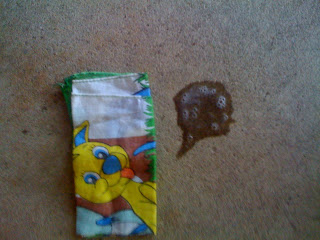Carbohydrate- fibrous

Celery is an example of carbohydrate- fibrous. Fibrous carbohydrates help move starch through the human body system and, in the process, allow the body to extract their nutritional elements. These fibrous carbohydrates come predominantly from roughage such as green leafy vegetables, broccoli and and the skins of various vegetables and fruits.
Amylase

Saliva is an example of amylase. Amylase is
is an enzyme that breaks starch down into sugar and is present in human saliva. When eating starchy foods amylase turns some of their starch into sugar in the mouth and helps with the process of digestion.
Endosperm

Wheat is an example of endosperm. Endosperm is a nutritive tissue surrounding the embryo within seeds of flowering plants. In wheat, the endosperm is the part of the grain used to make white flour. In wheat most of the protein and carbohydrates are stored in the endosperm and about about 25 percent of the fiber in wheat is found in the endosperm.
Connective Tissue

This knee is an example of connective tissue. Connective tissue is tissue that adds support and structure to the body.
Most connective tissue has fibrous strands of collagen that adds strength to the connective tissue. Tendons, ligaments, cartilage, bone and fat tissue are all examples of connective tissue.
Fruit- Fleshy with seed

This watermelon is an example of fruit fleshy with seed. Like this watermelon most fruit- fleshy with seed are thick-fleshed, smooth-skinned fruit that may contain several seeds or just one. It can be subdivided again from the form of a single or group of flowers.
Eukaryote

My cousin's dog, Onyx, is an example of an eukaryote. An eukaryote is an organism whose cells are organized into complex structures enclosed within membrane surrounding the nucleus. Since all dogs are multicellular, and move with the aid of cilia, flagella, and contains nucleuses they are consider to be a eukaryote.
Keratin

This picture of hair is an example of Keratin. Keratin is a strong and insoluble fibrous scleroprotein that is a major component in hair and also has varoius levels of amino acids that can either be of a hard or soft texture. Keratin is a very useful protein becuase it is easily made by the body and can act as a protectant, insulation, or as a defense( horns of a rhinoceros).
Stem- herbaceous

This Begonia plant has herbaceous stems which helps the plant take in water to an extreme. Herbaceous stems are plants that does not form a persistent woody stem. Genetics, climate, cold-hardiness, and length of daylight are some of the factors that determine herbaceous plants. Most herbaceous plants are annual and their stems grow longer at the tip as the cells divide in the apical meristem.
Cuticle layer of a plant

This leaf gloss is an example of a cuticle layer of a plant.The cuticle layer of a plant is very resistant and has high fossilization potential. These cuticle layers protects the underlying tissues of the palnt and also against dessication, UV radiation, and chemical biological agents.
Modified leaf of a plant

The picture shows leafs that have been bit on and eaten through by insects. Since this leaf is no longer in its orginal state it has been modified to accomadate a certain insects. These leafs have been adapted due to its environment. However, modified leafs can also benefit themselves by capturing the insects to get the additional supply of nitrogen from the bodies of the insects.
No comments:
Post a Comment